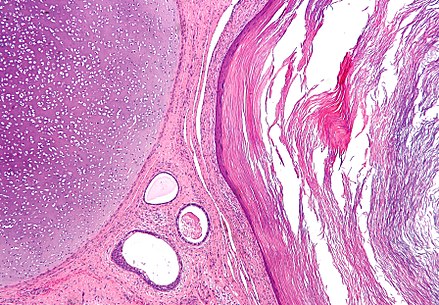Teratoma
A teratoma is a type of germ cell tumour composed of multiple types of tissues, such as hair, muscle, teeth, or bone.
These tumours can appear in various body regions but are most commonly found in the tailbone (sacrococcygeal teratoma), ovary, or testicle. Teratomas are classified into two main types: mature and immature, with mature teratomas generally being benign and immature teratomas often being malignant.

Signs and Symptoms
Symptoms of teratomas can be minimal, particularly if the tumour is small. Testicular teratomas often present as painless lumps. Complications can include ovarian torsion, testicular torsion, and hydrops fetalis. In adults, testicular teratomas are generally cancerous, whereas most ovarian teratomas are mature and hence benign.


Diagnosis
Teratomas are often diagnosed through tissue biopsy. Imaging techniques like CT scans and MRIs are also used for diagnosis. Prenatal ultrasound can detect sacrococcygeal and cervical teratomas. MRI of the pregnant uterus may be required for teratomas located within the foetal body. Additional diagnostic methods include prenatal magnetic resonance imaging, and in rare cases, foetal surgery may be indicated.


Treatment
The primary treatment for teratomas is surgical removal. This is usually effective as teratomas are well-encapsulated and non-invasive to surrounding tissues. Exceptions include brain teratomas and very large, complex teratomas that intertwine with adjacent structures. For malignant teratomas, surgery is often followed by chemotherapy. In some cases, chemotherapy is administered prior to surgery to reduce tumour size or manage complex cases.
Types
Mature Teratoma
Mature teratomas, also known as grade 0 teratomas, are highly variable in form and histology and may be solid, cystic, or a combination. These teratomas often contain a variety of tissue types like skin, muscle, and bone. Mature teratomas are generally benign, with only 0.17-2% becoming malignant.
Immature Teratoma
Immature teratomas contain immature tissues and typically show primitive or embryonal neuroectodermal histopathology. These are malignant and have one of the lowest rates of somatic mutation among tumour types.
Gliomatosis Peritoneii
This rare condition involves the deposition of mature glial cells in the peritoneum and is almost exclusively seen with ovarian teratoma.
Dermoid Cyst
A dermoid cyst is a type of mature cystic teratoma containing hair and other structures characteristic of normal skin and tissues derived from the ectoderm.
Foetus in fetu and Fetiform Teratoma
These rare forms of mature teratomas include components resembling malformed foetuses and may contain complex organ systems. Foetus in fetu differs from fetiform teratoma in having an apparent spine and bilateral symmetry.
Struma Ovarii
Struma ovarii is a rare form of mature teratoma that contains mostly thyroid tissue.
Epignathus
Epignathus is a rare teratoma originating in the oropharyngeal area, presenting as a mass protruding from the mouth at birth. An EXIT procedure is often recommended for initial treatment.
Pathophysiology
Teratomas belong to the class of nonseminomatous germ cell tumours, arising from abnormal development of pluripotent cells. Teratomas of germ cell origin occur in the testicles and ovaries, while those of embryonic origin can arise in various midline locations. Rarely, teratomas may include complex body parts like teeth or brain matter.

Epidemiology
Sacrococcygeal teratomas are the most common teratomas in newborns, diagnosed in approximately one in 30,000 newborns. Ovarian teratomas account for about a quarter of ovarian tumours, while testicular teratomas make up nearly half of testicular cancers. Teratomas can also occur in other animals, including mares, mountain lions, and canines.
Use in Stem Cell Research
Teratomas are used in stem cell research due to their ability to generate multiple tissue types. The "teratoma assay" is a gold-standard validation assay for pluripotent stem cells, demonstrating their potential for future regenerative medicine therapies. Researchers are looking at methods to prevent teratoma formation in patients receiving stem cell therapies.
Self-assessment MCQs (single best answer)
What is a teratoma composed of?
Where are teratomas most commonly found?
What is the main difference between mature and immature teratomas?
What is the primary treatment for teratomas?
What imaging technique is often used to diagnose teratomas?
What rare condition involves the deposition of mature glial cells in the peritoneum?
Which of the following is NOT a type of mature teratoma?
What is the main characteristic of immature teratomas?
Which teratoma type is characterised by the presence of thyroid tissue?
In which animal species are teratomas also known to occur?
Dentaljuce
Dentaljuce provides Enhanced Continuing Professional Development (CPD) with GDC-approved Certificates for dental professionals worldwide.
Founded in 2009 by the award-winning Masters team from the School of Dentistry at the University of Birmingham, Dentaljuce has established itself as the leading platform for online CPD.
With over 100 high-quality online courses available for a single annual membership fee, Dentaljuce offers comprehensive e-learning designed for busy dental professionals.
The courses cover a complete range of topics, from clinical skills to patient communication, and are suitable for dentists, nurses, hygienists, therapists, students, and practice managers.
Dentaljuce features Dr. Aiden, a dentally trained AI-powered personal tutor available 24/7 to assist with queries and provide guidance through complex topics, enhancing the learning experience.
Check out our range of courses, or sign up now!


